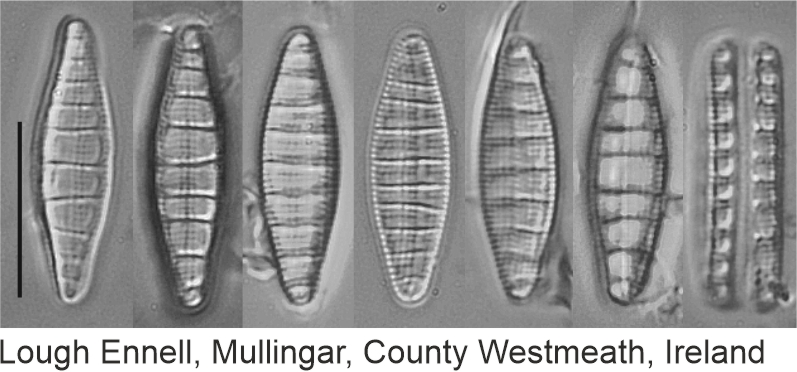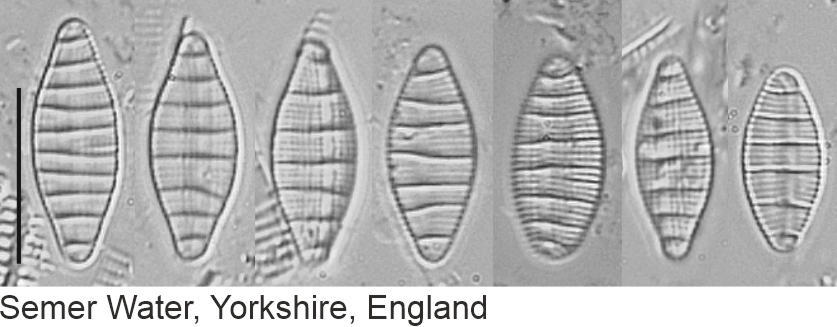Denticula tenuis Kützing; 1844; 43
Key references
Krammer K., Lange-Bertalot H. 1988. Süßwasserflora Mitteleuropas. Bacillariophyceae. 2. Teil. Bacillariophyceae, Epithemiaceae, Surirellaceae. Eds. Ettl H., Gerloff J., Heynig H., Mollenhauer D., Gustav Fischer Verlag, Stuttgart. 596 pp
Hamsher S.E., Graeff C.L., Stepanek J.G., Kociolek J.P. 2014. Frustular morphology and polyphyly in freshwater Denticula (Bacillariophyceae) species, and the description of Tetralunata gen. nov. (Epithemiaceae, Rhopalodiales). Plant Ecology and Evolution. 147(3): 346–365.
Morphology
Size
Length (6)7.5-30(43) µm, width 3-7 µm.
Shape
Lanceolate, sometimes rhombic or elliptical, with rounded to slightly protracted poles.
Symmetry
Isopolar, bilaterally symmetrical.
Raphe
Not visible in LM, its presence can be detected by the subraphe canal beneath the raphe, which is much more obvious and appears as two closely spaced, parallel, longitudinal lines in a subcentral position; these cross the partitions (marking where the partitions become fibulae). Between each pair of adjacent partitions/fibulae is a faint but distinct elliptical aperture, which is the opening between the subraphe canal and the cell lumen, formed by flaring of the fibula bases.
In a frustule, the raphe systems of the two valves lie on opposite sides ('nitzschioid symmetry').
Other features
The fibulae extend into prominent partitions, which traverse the whole width of the valve and appear in the light microscope as dark bars ('costae') connecting the valve margins .
The first girdle band (valvocopula) is open (i.e. it is continuous around one pole, but discontinuous at the other) and bears a series of small projections that, in vivo, fit around the valve partitions.
Length (6)7.5-30(43) µm, width 3-7 µm.
Shape
Lanceolate, sometimes rhombic or elliptical, with rounded to slightly protracted poles.
Symmetry
Isopolar, bilaterally symmetrical.
Raphe
Not visible in LM, its presence can be detected by the subraphe canal beneath the raphe, which is much more obvious and appears as two closely spaced, parallel, longitudinal lines in a subcentral position; these cross the partitions (marking where the partitions become fibulae). Between each pair of adjacent partitions/fibulae is a faint but distinct elliptical aperture, which is the opening between the subraphe canal and the cell lumen, formed by flaring of the fibula bases.
In a frustule, the raphe systems of the two valves lie on opposite sides ('nitzschioid symmetry').
Other features
The fibulae extend into prominent partitions, which traverse the whole width of the valve and appear in the light microscope as dark bars ('costae') connecting the valve margins .
The first girdle band (valvocopula) is open (i.e. it is continuous around one pole, but discontinuous at the other) and bears a series of small projections that, in vivo, fit around the valve partitions.
Literature
References are given in chronological order.
Reference |
Citation |
|---|---|
| Kützing F.T. 1844. Die Kieselschaligen Bacillarien oder Diatomeen. Fr. Fritsch, Nordhausen. 152 pp; 30 pls | Description; Illustrations; Morphology |
| Gotoh T. 1985. Girdle Structure of Diatom Denticula tenuis Kütz. var. crassula (Naeg. ex Kütz.) W. & G.S. West. Diatom. 1: 9-17. | Morphology; Illustrations |
| Krammer K., Lange-Bertalot H. 1988. Süßwasserflora Mitteleuropas. Bacillariophyceae. 2. Teil. Bacillariophyceae, Epithemiaceae, Surirellaceae. Eds. Ettl H., Gerloff J., Heynig H., Mollenhauer D., Gustav Fischer Verlag, Stuttgart. 596 pp | Morphology; Illustrations; Taxonomy; |
| Hofmann G., Werum M., Lange-Bertalot H. 2011. Diatomeen im Süßwasser-Benthos von Mitteleuropa. A.R.G. Gantner, Ruggell. 908 pp | Morphology; Ecology; Illustrations |
| Hamsher S.E., Graeff C.L., Stepanek J.G., Kociolek J.P. 2014. Frustular morphology and polyphyly in freshwater Denticula (Bacillariophyceae) species, and the description of Tetralunata gen. nov. (Epithemiaceae, Rhopalodiales). Plant Ecology and Evolution. 147(3): 346–365. | Morphology; Illustrations; |
This page should be cited as:
Mann D. G. Denticula tenuis Kützing; 1844; 43. In: Jüttner I., Carter C., Cox E.J., Ector L., Jones V., Kelly M.G., Kennedy B., Mann D.G., Turner J. A., Van de Vijver B., Wetzel C.E., Williams D.M..
Freshwater Diatom Flora of Britain and Ireland. Amgueddfa Cymru - National Museum Wales. Available online at https://naturalhistory.museumwales.ac.uk/diatoms/browsespecies.php?-recid=3342. [Accessed:
].
Record last modified: 27/12/2020



